“The Americans with Disabilities Act (ADA) was signed into law on July 26, 1990, by President George H.W. Bush. The ADA is one of America’s most comprehensive pieces of civil rights legislation that prohibits discrimination and guarantees that people with disabilities have the same opportunities as everyone else to participate in the mainstream of American life — to enjoy employment opportunities, to purchase goods and services, and to participate in State and local government programs and services.” – (Excerpt from ADA.gov)
While there is a whole host of exceptions in place within the actual legislation of the ADA, we won’t get into those today. Instead, we’ll be walking you through what you actually need and why you need it. In regards to signage, the laws within the ADA mandate standards including character size, color contrast, location and tactile copy for readability to ensure equal access to those with disabilities.
To kick things off we’re going to dig into a few important questions…so buckle up, we’re about to hit the gas.
Do my signs need to be ADA compliant? The short answer is, maybe. This all depends on your local building codes. But make sure you do your research! If your signs are noncompliant, you may not pass inspection and a certificate of occupancy or CO may not be granted.
What kinds of signs need to follow ADA? All interior and exterior permanent rooms and spaces must follow ADA regulations. That’s not all though, don’t forget about safety signs that identify exits and stairwells.
What is “permanent signage”? Anything that will identify a certain location for longer than seven days. Think of restroom signs, room numbers, etc. These kinds of signs must have both tactile copy as well as braille. The exemptions to this are overhead, flag-mounted and wall-mounted signage; these signs must follow ADA regulations but are not required to have tactile copy or braille.
What sign types do not need to follow ADA regulations? Many signs are actually exempt from ADA codes; building addresses, directories, company names and logos, menus, occupant names, seat and row designations in assembly areas, signs in parking facilities (with the exception of accessible parking space signs), signs not located in public use areas in detention and correctional facilities, evacuation maps and temporary signs that are in place for less than seven days.
Do I need to update my current signage? If signage in existing facilities already complies with the 1991 ADA, and is not being altered, you are not required to update it with changes in the 2010 Standards.
Do I need to use a particular font? Yes. No serif fonts are compliant with ADA code. Avenir, Futura, Din, Meta, Helvetica and Optima are all popular fonts here at Office Sign Company.
*A note on California ADA Regulations: Though nationwide, ADA code requires only one restroom sign, California requires two. One being the typical tactile sign with braille and the second being a large geometric shape on the door itself. This being said, placement and installation of these signs are very important. The geometric shape is required to to centered horizontally in the center of the door at a height of 60 inches above the floor to the center of the symbol. The federally regulated ADA sign with tactile text, braille and any images should be mounted at a height of 60 inches above the floor to the center of the sign. The sign should be located on the wall adjacent to the latch side of the door. Where there is no wall space on the latch side, the sign should be placed on the nearest adjacent wall, preferably on the right.
Want to dive more into the nitty gritty of ADA compliant signage? We’d love to chat! And when you’re ready to order your ADA compliant signage, give us a call! at 701.526.3835 or shoot an email to service@officesigncompany.com and we’ll get you set up with the right signage for your needs.




